Duriense
Wine region: DURIENSE
The beginning of viticulture must have had their origins in the Chalcolithic Period, but the earliest evidence from archaeological excavations revealed Roman wine presses with fixed covers of the type of with press weights and two crossed axes (Foz‑Côa, Murça, Meda, etc.). The Douro is the region with the earlierst viticultural demarcations defined in the Modern Age. In 1756, the Marquis of Pombal set the boundaries of the wine‑producing areas of the Douro, which have remained practically unchanged to this day, although they have since been geographically subdivided into three regions, namely the Baixo Corgo, Alto Corgo and Douro Superior. Port wine (with its high alcohol content of 19% – 22% vol.) had already gained significant momentum in the 15th century because of English commercial interest. The secret of success was strict control by a kind of “special monitoring force” established to ensure quality and prevent fraud. By means of an incentive scheme, this monitoring force regulated the adjustment of production quotas to meet market demand based on analysis and evaluation of various production criteria (such as location of vineyard, slope, microclimate, varieties, soil type, six different yield classifications, etc.) in order to stimulate the interest of producers in making distinctions when evaluating the quality of their vineyards and wines.
With the recent, significant increase in the prestige accorded wine, it has been possible to coordinate policies channelled through the offices of the Instituto do Vinho de Douro e do Porto, I.P. (“Vine Institute of the Douro and Porto”). The Universidade de Trás‑os‑Montes and the ADVID association The University of Trás‑os‑Montes e Alto Douro, the association ADVID and as well as other organisations formed the basis of a continuing “rationale of joint action”. The region as it is currently demarcated covers in the order of 250,000 hectares, of which approximately 45,000 hectares are under vineyard cultivation.
The climatic conditions are typically Mediterranean, varying according to the location of the vineyard on slopes on the banks of rivers and streams. Because of its impressive geological structure associated with man’s cultivation of the vine, the region incorporating the valleys of Alto Douro has been recognised as a World Heritage site by UNESCO. The geological composition of many of the soils of the Douro is based on different types of metamorphic schists. Granite is rarely encountered, and when it is, the soils are considered of too poor a quality to qualify for the “incentive” normally given for the production of Porto wine. Most of the soils are classified as Leptosols (from the Greek leptos, meaning delicate, or small), with a shallow layer of soil over hard rock. The soils are more fertile because of their granitic origin. The high degree of surface gravel limits water loss and promotes the microclimate at plant level. The acidic pH levels of most of the soils (with the exception of the Douro Superior) and the steeply inclined vineyard slopes require human intervention for proper cultivation. The abundance of water, on average more than 600 mm/m2, together with other edapho‑climatic conditions produces constant stress on the vine itself, thus guaranteeing the quality of the wines of the region.
The Instituto dos Vinhos do Douro e do Porto, I.P. (The Wine Institute of the Douro and Porto), abbreviated to IVDP, is the certification authority for DO and IG vitivinicultural products in this region.
Types of vitivinicultural products
Porto DO wines (VLQPRD): White and red, of different styles: Ruby, Tawny, White, Vintage, LBV, year of harvest, aged (10/20/30/40 years), and Reserva.
Duriense IG wine or Duriense regional wine: Red, white, rosé.
Douro DO wines (VQPRD): Red, white, rosé.
Douro DO sparkling wines (VEQPRD)
Douro DO liqueur wines (VLQPRD) “Moscatel do Douro”
Aguardente de Vinho (brandy from wine spirit)
The Mateus Palace (source: Wikipedia/Varun Shiv Kapur)
Douro Valley (Douro Wine Route)
Regional Contacts
Technical information: IVDP, I.P. – INSTITUTO DOS VINHOS DO DOURO E DO PORTO, I.P. (“Vine Institute of the Douro and Porto”), Rua dos Camilos, 905050‑272 PESO DA RÉGUA, Tel.: 254 320 130, Fax: 254 320 149 Website: www.ivdp.pt, e‑mail: ivdp@ivdp.pt
Cultural information on the wine of the region: Confraria Enófila do Vinho do Porto (“Wine of Porto Oenophilists’ Society”), rua Dr. Antonio Granjo, 207, 4400‑124 Vila Nova da Gaia, Tel. 223745525, Website: confrariavinhodoporto.com.
Institutions of higher education: Universidade de Trás‑os‑Montes e Alto Douro UTAD, Quinta dos Prados 5000‑262 Vila Real, Tel. 259350000, www.utad.pt; Escola Superior Agraria de Bragança, Campus de Santa Apolónia – Apartado 1172, 5301‑855 Bragança; Telephone: (+351) 273 303 200 http://esa.ipb.pt; Confraria dos Enófilos da Região Demarcada do Douro (“Oenophilists’ Society of the Designated Douro Region”), Praça Renato Aguiar‑ Edif. S. Tomé, r/C esq. 5050 Peso‑da‑Regua, Tel. 254 321 323
Certification authority: IVDP, I.P. – INSTITUTO DOS VINHOS DO DOURO E DO PORTO, I.P. Rua dos Camilos, 905050‑272 PESO DA RÉGUA, Tel.: 254 320 130, Fax: 254 320 149 Website: www.ivdp.pt, e‑mail: ivdp@ivdp.pt; Porto, Rua Ferreira Borges, 27 4050‑253 Porto – Tel: +351 222071600;
Eno‑tourism information: Porto Wine Routes, Largo da estação 5050‑237 Peso da Regua, Tel 254324774, site: www.rvp.pt

Producer and bottler information on wine from the Douro and Porto region: http://www.ivv.min‑agricultura.pt/np4/1736.html, → Yearbook 2011, pages 130–140. Wine Route website: www.rvp.pt
Designation: IGP “Duriense” (Regional wine)

IGP Legislation: Decree‑Law No. 212/2004, Decree‑Law No. 173/2009, Reg. (EC)1234/2003 (applies to all varieties mentioned below)
DOP “Porto” (Vinho de Porto/Port wine)

DOP Legislation: Ministerial Directive No. 413/2001, Decree‑Law No. 212/2004, Decree‑Law No. 173/2009, and Reg. (EC) No. 1234/2007 (as amended by Reg. (EC) No. 491/2009).
(DOP varieties in bold)
RED WINES:Alicante Bouschet, Alvarelhão, Alvarelhão‑Ceitão, Aragonez (Tinta Roriz), Aramon, Baga, Barca, Barreto, Bastardo, Bragão, Cabernet Franc, Cabernet Sauvignon, Camarate, Carignan, Carrego Tinto, Casculho, Castelâ, Castelão, Cidadelhe, Concieira, Cornifesto, Corropio, Donzelinho Tinto, Engomada, Espadeiro, Gamay, Gonçalo Pires, Gorda, Grand Noir, Grangeal, Grenache, Jaen, Lourela, Malandra, Malvasia Preta, Marufo, Melra, Merlot, Mondet, Moscatel Galego Tinto, Mourisco de Semente, Mourisco de Trevões, Nevoeira, Patorra, Petit Bouchet, Petit Verdot Pinot Noir, Português Azul, Preto Marinho, Ricoca, Rioseira, Rufete, Santareno, São Saúl, Sevilhão, Sousão, Syrah, Tannat, Tinta Aguiar, Tinta Barroca, Tinta Carvalha, Tinta Fontes, Tinta Francisca, Tinta Lameira, Tinta Martins, Tinta Mesquita, Tinta Panajoia, Tinta Pereira, Tinta Pomar, Tinta Tabuaço, Tinto Cão, Tinto Sem Nome, Touriga Fêmea, Touriga Franca, Touriga Nacional, Trincadeira (Tinta Amarela), Valdosa, Verejoa, Vinhão, Zinfandel, Donzelinho‑Roxo, Gewurztraminer, Moscatel Galego Roxo (Moscatel Roxo).
WHITE WINES:Alicante Branco, Alvarelhão Branco, Arinto (Pedernã), Avesso, Batoca, Bical, Branco‑Especial, Branco Guimarães, Branda, Caramela, Carrega Branco, Cercial, Chardonnay, Chausselas, Chenin, Côdega de Larinho, Diagalves, Dona Branca, Donzelinho Branco, Dorinto, Estreito‑Macio, Fernão Pires (Maria Gomes) Folgasão, Godelho, Gouveio, Gouveio‑Estimado, Gouveio Real, Jampal, Malvasia Fina, Malvasia Parda, Malvasia‑Rei, Moscadet, Moscatel Galego Branco, Mourisco Branco, Muller‑Thurgau, Pé Comprido, Pinheira‑Branca, Pinot‑Blanc, Praça, Rabigato, Rabigato‑Franco, Rabigato‑Moreno, Rabo de Ovelha, Ratinho, Riesling, Samarrinho, Sarigo, Sauvignon, Semillon, Sercial, Síria, Tália, Tamarez, Terrantez, Touriga Branca, Trigueira, Valente, Verdelho, Verdial Branco, Viognier, Viosinho and Vital
Designation: DOP “Douro” VQPRD

Legislation: Decree‑Law No. 212/2004, Decree Law No. 173/2009 and Reg. (EC) No. 1234/2007 (as amended by Reg. (EC) No. 491/2009).
RED VARIETIES: Barreto, Bastardo, Bragão, Camarate, Carignan, Carrega Tinto, Casculho, Castelã, Castelão (Periquita), Cidadelhe, Concieira, Cornifesto, Corropio, Donzelinho Tinto, Engomada, Espadeiro, Gonçalo Pires, Grand Noir, Grangeal, Jaen, Lourela, Malandra, Malvasia Preta, Marufo, Melra, Mondet, Mourisco de Semente, Nevoeira, Patorra, Petit Bouschet, Pinot Noir, Português Azul, Preto Martinho, Ricoca, Roseira, Rufete, Santareno, São Saúl, Sevilhão, Sousão, Tinta Aguiar, Tinta Barroca, Tinta Carvalha, Tinta Fontes, Tinta Francisca, Tinta Lameira, Tinta Martins, Tinta Mesquita, Tinta Penajóia, Tinta Pereira, Tinta Pomar, Tinta Tabuaço, Tinto Cão, Tinto Sem Nome, Touriga Fêmea, Touriga Franca, Touriga Nacional, Trincadeira (Tinta Amarela), Valdosa and Varejoa.
WHITE VARIETIES: Alicante Branco, Alvarelhão Branco, Arinto (Pedernã), Avesso, Batoca, Bical, Branco Especial, Branco Guimarães, Caramela, Carrega Branco, Cercial, Chasselas, Côdega de Larinho, Diagalves, Dona Branca, Donzelinho Branco, Estreito Macio, Fernão Pires (Maria Gomes), Folgasão, Gouveio, Gouveio Estimado, Gouveio Real, Jampal, Malvasia Fina, Malvasia Parda, Malvasia Rei, Moscadet, Moscatel Galego Branco, Mourisco Branco, Pé Comprido, Pinheira Branca, Praça, Rabigato, Rabigato Franco, Rabigato Moreno, Rabo de Ovelha, Ratinho, Samarrinho, Sarigo, Semillon, Sercial (Esgana Cão), Síria (Roupeiro), Tália, Tamarez, Terrantez, Touriga Branca, Trigueira, Valente, Verdial Branco, Viosinho and Vital.





